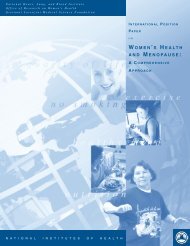HeartsNParks Community Mobilization Guide - National Heart, Lung ...
HeartsNParks Community Mobilization Guide - National Heart, Lung ...
HeartsNParks Community Mobilization Guide - National Heart, Lung ...
Create successful ePaper yourself
Turn your PDF publications into a flip-book with our unique Google optimized e-Paper software.
P HYSICAL A CTIVITY T IPS<br />
As a <strong>Heart</strong>s N’ Parks coordinator, you have a unique and remarkable opportunity to positively<br />
impact your participants’ lives by exposing them to the fulfilling and fun rewards of physical activity.<br />
Below are a few tips to ensure that your physical activity-based programs are effective for participants<br />
of all ages:<br />
■ Encourage activities that can be done easily throughout life.<br />
■ Focus instructional feedback on process, not product.<br />
■ Offer a diverse range of competitive and noncompetitive activities appropriate for different<br />
ages and abilities.<br />
■ Provide participants with the skills and confidence they need to be physically active.<br />
■ Individualize activities.<br />
■ Make sure activities are inclusive and get everyone off the sidelines.<br />
■ Be an active role model. Get out there and join in the fun.<br />
obesity, and other ailments. It may also help<br />
prevent problems related to mobility. It is<br />
never too late for seniors to start being<br />
physically active. Moreover, studies have<br />
shown that when seniors visit community<br />
parks for recreation and activity they acquire a<br />
feeling of renewal and social fulfillment, which<br />
provides further incentive to continue being<br />
physically active. Walking and playing with<br />
grandchildren are activities seniors can enjoy<br />
for moderate activity. Swimming, jogging,<br />
or biking are more intense and should only be<br />
undertaken by seniors who have checked with<br />
a doctor first.<br />
Kids and Physical Activity<br />
Keep in mind that kids, especially 6- to 10-yearolds,<br />
are usually different from adults in the<br />
way they engage in physical activity. Most kids<br />
tend to have quick bursts of energy that come<br />
between longer periods of rest, which is perfectly<br />
normal and should be encouraged. However, if<br />
the children you work with are in the 11- to<br />
14-year-old range, they may be active for longer<br />
periods of time. It is a good idea to try to get a<br />
sense of your kids’ physical limitations early on<br />
and remain aware of how active they are during<br />
the program. This will help ensure that their<br />
level of intensity does not compromise the<br />
quality of the activity or lead to injuries.<br />
<strong>Heart</strong>-Healthy Eating<br />
Adopting a heart-healthy eating plan provides<br />
individuals with health benefits without the<br />
necessity of giving up favorite foods. Such an<br />
eating plan balances calorie intake with<br />
physical activity and is low in saturated fat,<br />
cholesterol, and sodium, and rich in fruits and<br />
vegetables, low-fat dairy foods, and whole<br />
grains. A heart-healthy eating plan can help<br />
protect against high blood pressure, high blood<br />
cholesterol, and overweight. It may also protect<br />
against cancer and other health problems.<br />
The earlier individuals take action to adopt a<br />
heart-healthy eating plan, the better. Research<br />
shows that heart disease begins early in life<br />
and that, once learned, bad habits are difficult<br />
to break.<br />
What is A <strong>Heart</strong>-Healthy Eating Plan?<br />
To follow a heart-healthy eating plan means<br />
basically eating some foods more often and<br />
9
















